Principles of Health Law and Regulatory Issues Final Assessment
VerifiedAdded on 2022/12/01
|10
|2723
|407
Quiz and Exam
AI Summary
This assessment covers key principles of health law and regulatory issues, evaluating understanding of patient rights, informed consent, and confidentiality. The questions address various aspects, including the validity of consent, the obligations of healthcare providers, and the implications of medical malpractice. Topics such as HIPAA, Stark Law, and the rights of minors are examined. The assessment also explores issues surrounding HIV/AIDS disclosure, health literacy, and the role of advance directives. The questions range from true/false statements to multiple-choice scenarios, testing comprehension of legal and ethical considerations in healthcare. This assessment is part of a course designed to provide a comprehensive overview of health law and its practical applications.
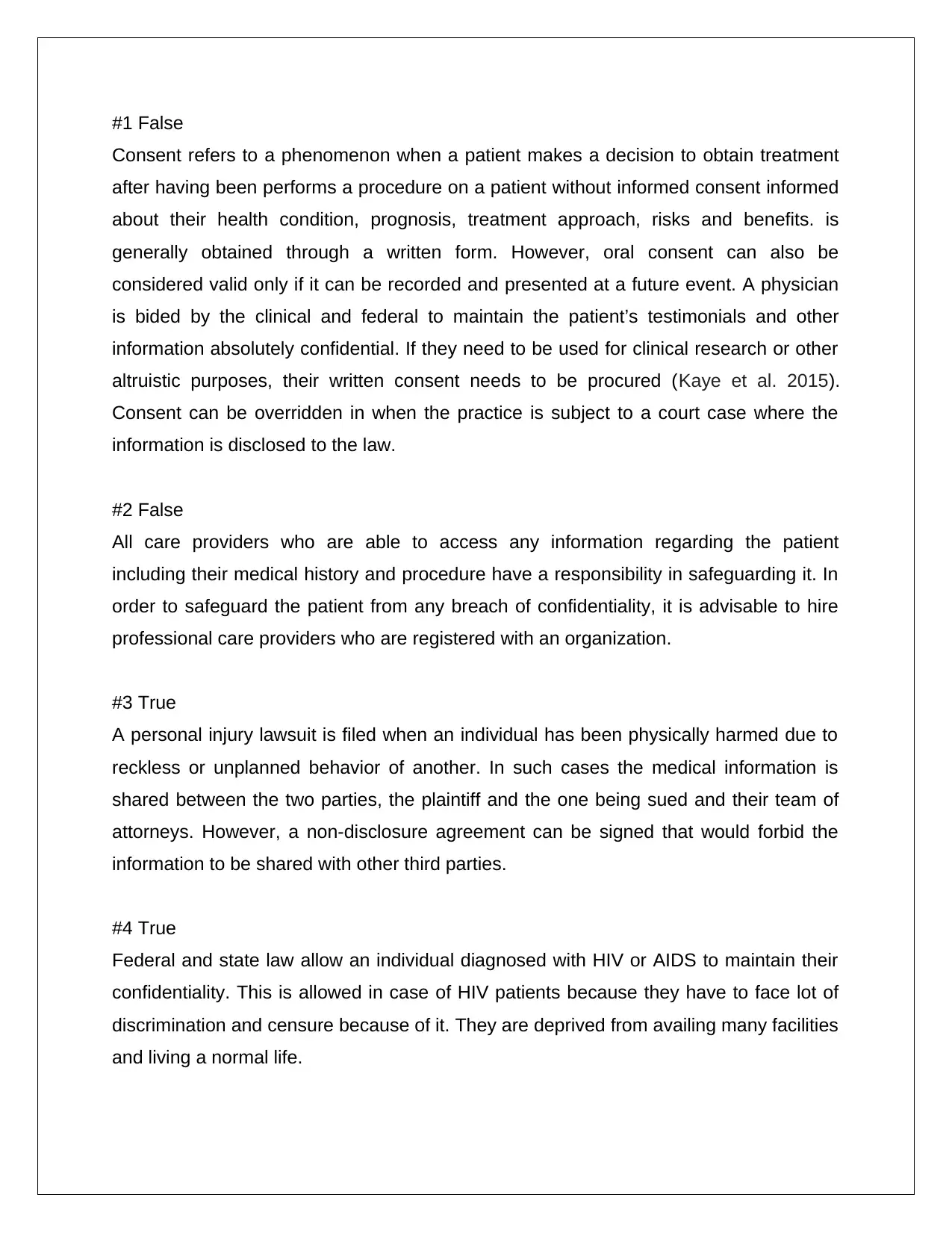
#1 False
Consent refers to a phenomenon when a patient makes a decision to obtain treatment
after having been performs a procedure on a patient without informed consent informed
about their health condition, prognosis, treatment approach, risks and benefits. is
generally obtained through a written form. However, oral consent can also be
considered valid only if it can be recorded and presented at a future event. A physician
is bided by the clinical and federal to maintain the patient’s testimonials and other
information absolutely confidential. If they need to be used for clinical research or other
altruistic purposes, their written consent needs to be procured (Kaye et al. 2015).
Consent can be overridden in when the practice is subject to a court case where the
information is disclosed to the law.
#2 False
All care providers who are able to access any information regarding the patient
including their medical history and procedure have a responsibility in safeguarding it. In
order to safeguard the patient from any breach of confidentiality, it is advisable to hire
professional care providers who are registered with an organization.
#3 True
A personal injury lawsuit is filed when an individual has been physically harmed due to
reckless or unplanned behavior of another. In such cases the medical information is
shared between the two parties, the plaintiff and the one being sued and their team of
attorneys. However, a non-disclosure agreement can be signed that would forbid the
information to be shared with other third parties.
#4 True
Federal and state law allow an individual diagnosed with HIV or AIDS to maintain their
confidentiality. This is allowed in case of HIV patients because they have to face lot of
discrimination and censure because of it. They are deprived from availing many facilities
and living a normal life.
Consent refers to a phenomenon when a patient makes a decision to obtain treatment
after having been performs a procedure on a patient without informed consent informed
about their health condition, prognosis, treatment approach, risks and benefits. is
generally obtained through a written form. However, oral consent can also be
considered valid only if it can be recorded and presented at a future event. A physician
is bided by the clinical and federal to maintain the patient’s testimonials and other
information absolutely confidential. If they need to be used for clinical research or other
altruistic purposes, their written consent needs to be procured (Kaye et al. 2015).
Consent can be overridden in when the practice is subject to a court case where the
information is disclosed to the law.
#2 False
All care providers who are able to access any information regarding the patient
including their medical history and procedure have a responsibility in safeguarding it. In
order to safeguard the patient from any breach of confidentiality, it is advisable to hire
professional care providers who are registered with an organization.
#3 True
A personal injury lawsuit is filed when an individual has been physically harmed due to
reckless or unplanned behavior of another. In such cases the medical information is
shared between the two parties, the plaintiff and the one being sued and their team of
attorneys. However, a non-disclosure agreement can be signed that would forbid the
information to be shared with other third parties.
#4 True
Federal and state law allow an individual diagnosed with HIV or AIDS to maintain their
confidentiality. This is allowed in case of HIV patients because they have to face lot of
discrimination and censure because of it. They are deprived from availing many facilities
and living a normal life.
Paraphrase This Document
Need a fresh take? Get an instant paraphrase of this document with our AI Paraphraser
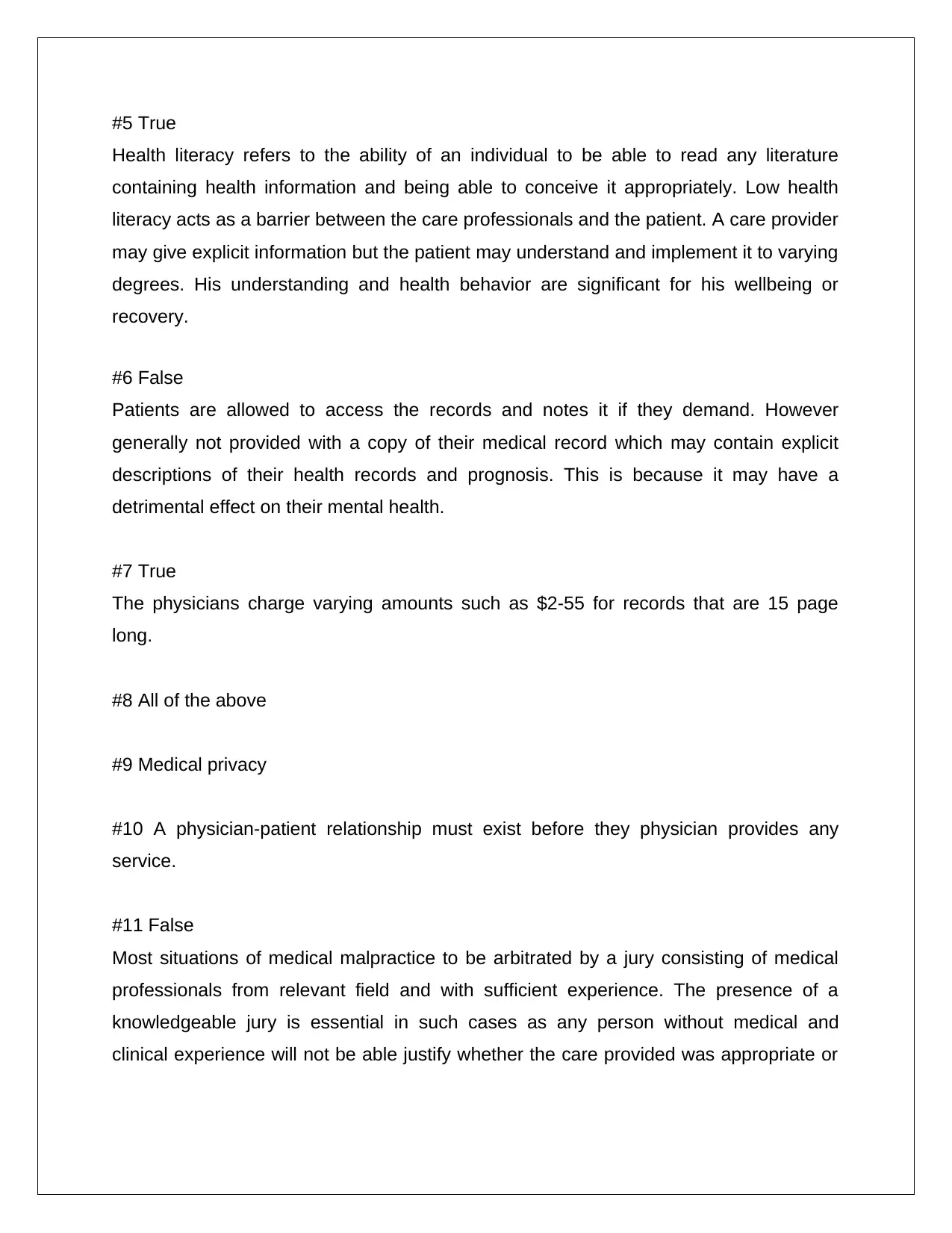
#5 True
Health literacy refers to the ability of an individual to be able to read any literature
containing health information and being able to conceive it appropriately. Low health
literacy acts as a barrier between the care professionals and the patient. A care provider
may give explicit information but the patient may understand and implement it to varying
degrees. His understanding and health behavior are significant for his wellbeing or
recovery.
#6 False
Patients are allowed to access the records and notes it if they demand. However
generally not provided with a copy of their medical record which may contain explicit
descriptions of their health records and prognosis. This is because it may have a
detrimental effect on their mental health.
#7 True
The physicians charge varying amounts such as $2-55 for records that are 15 page
long.
#8 All of the above
#9 Medical privacy
#10 A physician-patient relationship must exist before they physician provides any
service.
#11 False
Most situations of medical malpractice to be arbitrated by a jury consisting of medical
professionals from relevant field and with sufficient experience. The presence of a
knowledgeable jury is essential in such cases as any person without medical and
clinical experience will not be able justify whether the care provided was appropriate or
Health literacy refers to the ability of an individual to be able to read any literature
containing health information and being able to conceive it appropriately. Low health
literacy acts as a barrier between the care professionals and the patient. A care provider
may give explicit information but the patient may understand and implement it to varying
degrees. His understanding and health behavior are significant for his wellbeing or
recovery.
#6 False
Patients are allowed to access the records and notes it if they demand. However
generally not provided with a copy of their medical record which may contain explicit
descriptions of their health records and prognosis. This is because it may have a
detrimental effect on their mental health.
#7 True
The physicians charge varying amounts such as $2-55 for records that are 15 page
long.
#8 All of the above
#9 Medical privacy
#10 A physician-patient relationship must exist before they physician provides any
service.
#11 False
Most situations of medical malpractice to be arbitrated by a jury consisting of medical
professionals from relevant field and with sufficient experience. The presence of a
knowledgeable jury is essential in such cases as any person without medical and
clinical experience will not be able justify whether the care provided was appropriate or
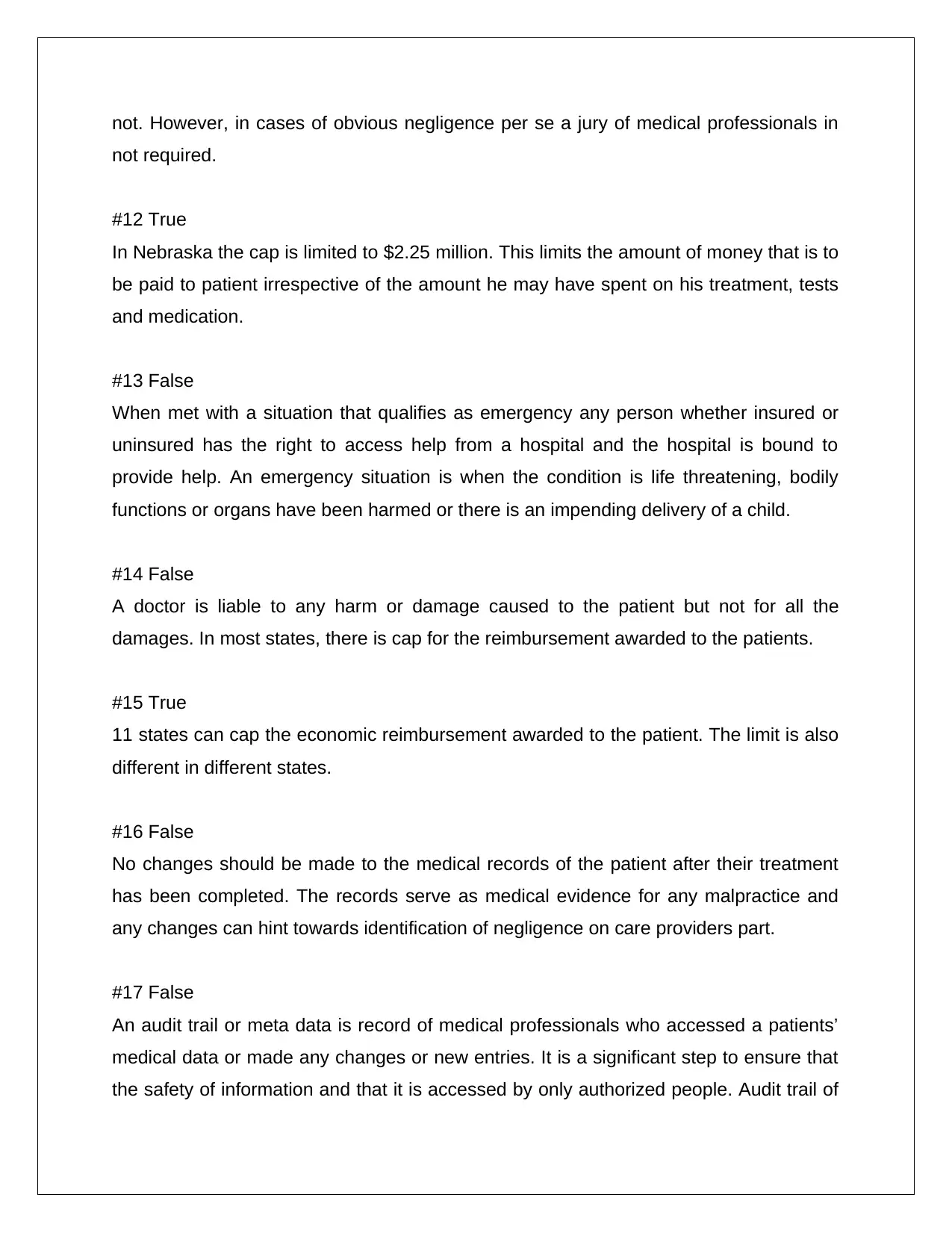
not. However, in cases of obvious negligence per se a jury of medical professionals in
not required.
#12 True
In Nebraska the cap is limited to $2.25 million. This limits the amount of money that is to
be paid to patient irrespective of the amount he may have spent on his treatment, tests
and medication.
#13 False
When met with a situation that qualifies as emergency any person whether insured or
uninsured has the right to access help from a hospital and the hospital is bound to
provide help. An emergency situation is when the condition is life threatening, bodily
functions or organs have been harmed or there is an impending delivery of a child.
#14 False
A doctor is liable to any harm or damage caused to the patient but not for all the
damages. In most states, there is cap for the reimbursement awarded to the patients.
#15 True
11 states can cap the economic reimbursement awarded to the patient. The limit is also
different in different states.
#16 False
No changes should be made to the medical records of the patient after their treatment
has been completed. The records serve as medical evidence for any malpractice and
any changes can hint towards identification of negligence on care providers part.
#17 False
An audit trail or meta data is record of medical professionals who accessed a patients’
medical data or made any changes or new entries. It is a significant step to ensure that
the safety of information and that it is accessed by only authorized people. Audit trail of
not required.
#12 True
In Nebraska the cap is limited to $2.25 million. This limits the amount of money that is to
be paid to patient irrespective of the amount he may have spent on his treatment, tests
and medication.
#13 False
When met with a situation that qualifies as emergency any person whether insured or
uninsured has the right to access help from a hospital and the hospital is bound to
provide help. An emergency situation is when the condition is life threatening, bodily
functions or organs have been harmed or there is an impending delivery of a child.
#14 False
A doctor is liable to any harm or damage caused to the patient but not for all the
damages. In most states, there is cap for the reimbursement awarded to the patients.
#15 True
11 states can cap the economic reimbursement awarded to the patient. The limit is also
different in different states.
#16 False
No changes should be made to the medical records of the patient after their treatment
has been completed. The records serve as medical evidence for any malpractice and
any changes can hint towards identification of negligence on care providers part.
#17 False
An audit trail or meta data is record of medical professionals who accessed a patients’
medical data or made any changes or new entries. It is a significant step to ensure that
the safety of information and that it is accessed by only authorized people. Audit trail of
⊘ This is a preview!⊘
Do you want full access?
Subscribe today to unlock all pages.

Trusted by 1+ million students worldwide
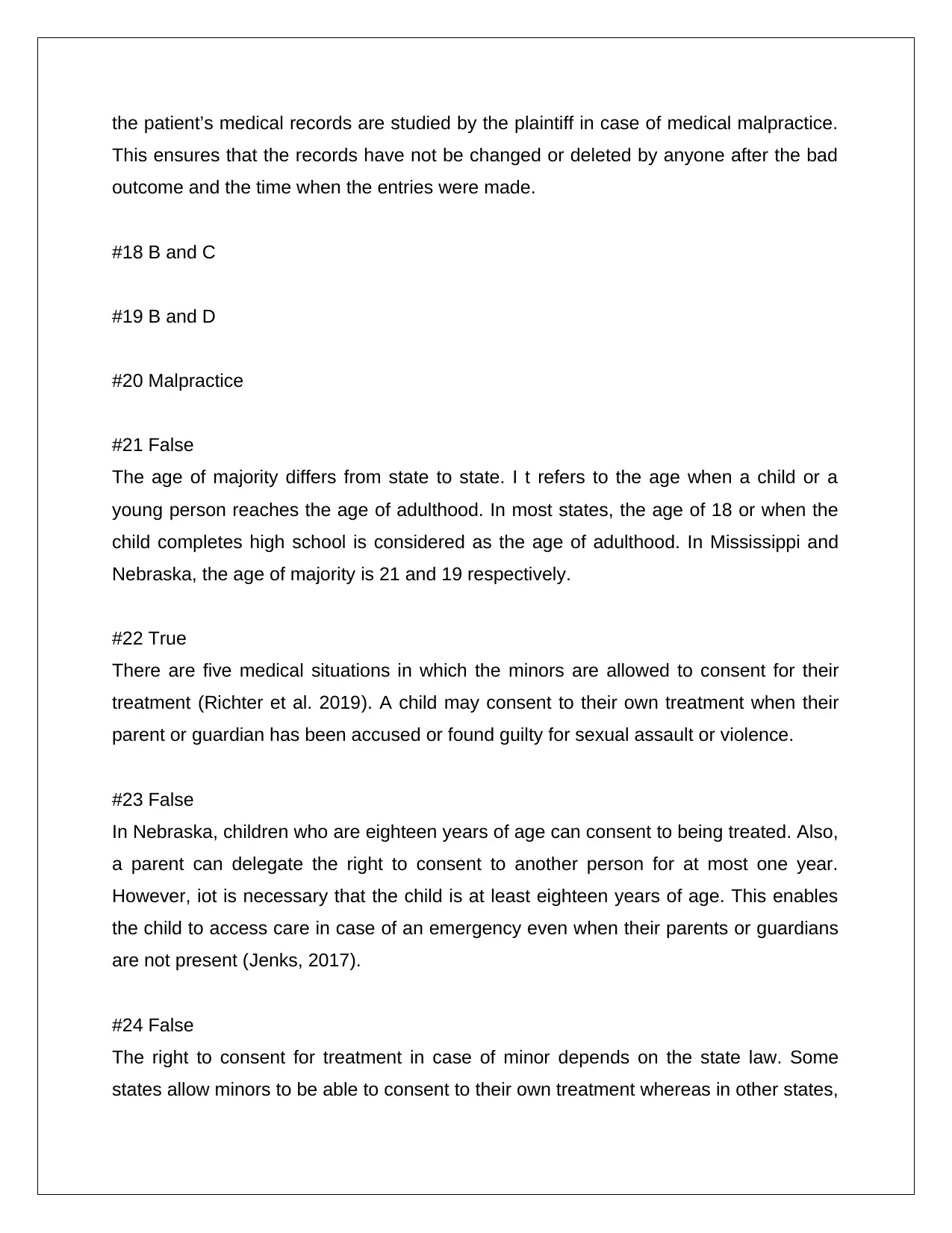
the patient’s medical records are studied by the plaintiff in case of medical malpractice.
This ensures that the records have not be changed or deleted by anyone after the bad
outcome and the time when the entries were made.
#18 B and C
#19 B and D
#20 Malpractice
#21 False
The age of majority differs from state to state. I t refers to the age when a child or a
young person reaches the age of adulthood. In most states, the age of 18 or when the
child completes high school is considered as the age of adulthood. In Mississippi and
Nebraska, the age of majority is 21 and 19 respectively.
#22 True
There are five medical situations in which the minors are allowed to consent for their
treatment (Richter et al. 2019). A child may consent to their own treatment when their
parent or guardian has been accused or found guilty for sexual assault or violence.
#23 False
In Nebraska, children who are eighteen years of age can consent to being treated. Also,
a parent can delegate the right to consent to another person for at most one year.
However, iot is necessary that the child is at least eighteen years of age. This enables
the child to access care in case of an emergency even when their parents or guardians
are not present (Jenks, 2017).
#24 False
The right to consent for treatment in case of minor depends on the state law. Some
states allow minors to be able to consent to their own treatment whereas in other states,
This ensures that the records have not be changed or deleted by anyone after the bad
outcome and the time when the entries were made.
#18 B and C
#19 B and D
#20 Malpractice
#21 False
The age of majority differs from state to state. I t refers to the age when a child or a
young person reaches the age of adulthood. In most states, the age of 18 or when the
child completes high school is considered as the age of adulthood. In Mississippi and
Nebraska, the age of majority is 21 and 19 respectively.
#22 True
There are five medical situations in which the minors are allowed to consent for their
treatment (Richter et al. 2019). A child may consent to their own treatment when their
parent or guardian has been accused or found guilty for sexual assault or violence.
#23 False
In Nebraska, children who are eighteen years of age can consent to being treated. Also,
a parent can delegate the right to consent to another person for at most one year.
However, iot is necessary that the child is at least eighteen years of age. This enables
the child to access care in case of an emergency even when their parents or guardians
are not present (Jenks, 2017).
#24 False
The right to consent for treatment in case of minor depends on the state law. Some
states allow minors to be able to consent to their own treatment whereas in other states,
Paraphrase This Document
Need a fresh take? Get an instant paraphrase of this document with our AI Paraphraser
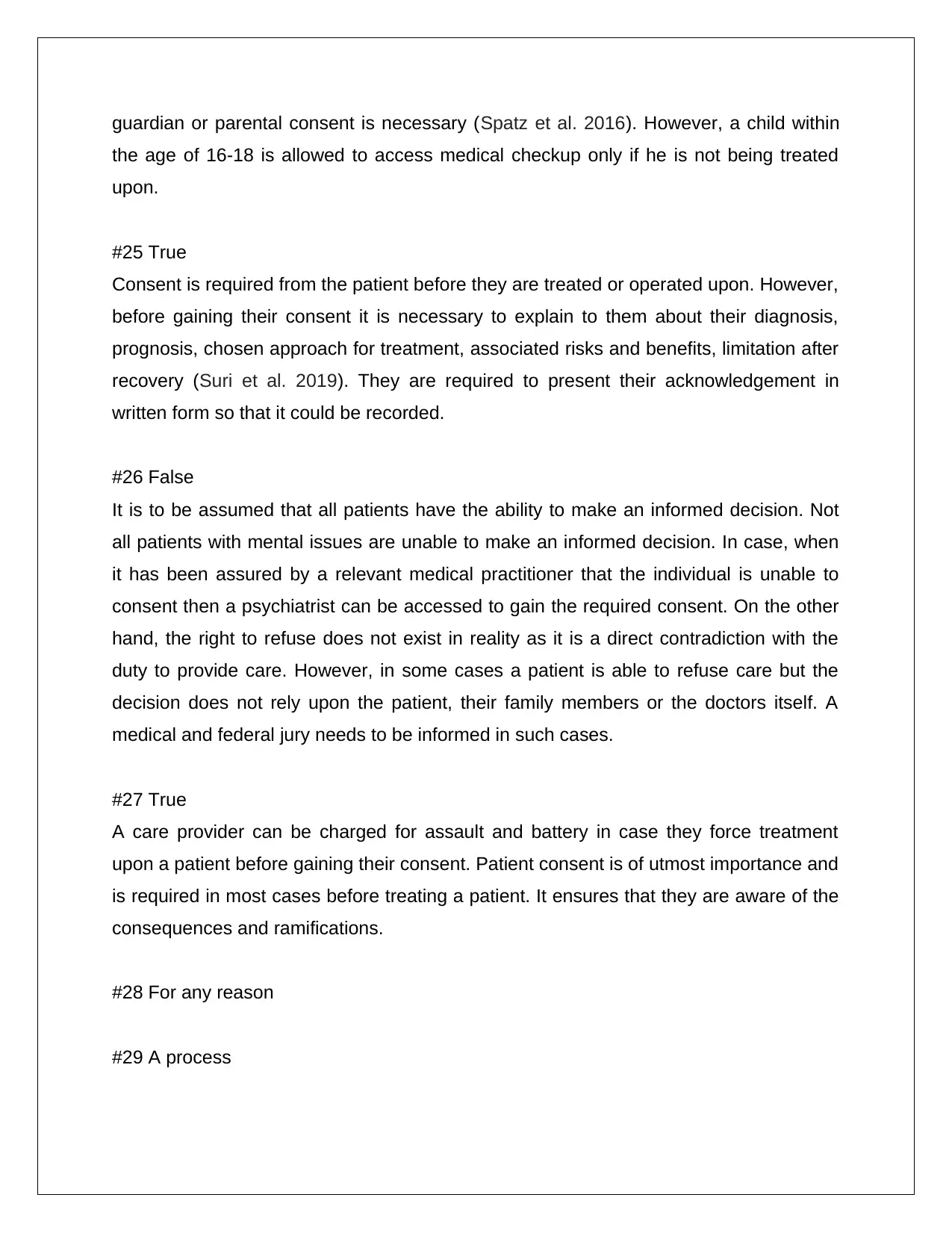
guardian or parental consent is necessary (Spatz et al. 2016). However, a child within
the age of 16-18 is allowed to access medical checkup only if he is not being treated
upon.
#25 True
Consent is required from the patient before they are treated or operated upon. However,
before gaining their consent it is necessary to explain to them about their diagnosis,
prognosis, chosen approach for treatment, associated risks and benefits, limitation after
recovery (Suri et al. 2019). They are required to present their acknowledgement in
written form so that it could be recorded.
#26 False
It is to be assumed that all patients have the ability to make an informed decision. Not
all patients with mental issues are unable to make an informed decision. In case, when
it has been assured by a relevant medical practitioner that the individual is unable to
consent then a psychiatrist can be accessed to gain the required consent. On the other
hand, the right to refuse does not exist in reality as it is a direct contradiction with the
duty to provide care. However, in some cases a patient is able to refuse care but the
decision does not rely upon the patient, their family members or the doctors itself. A
medical and federal jury needs to be informed in such cases.
#27 True
A care provider can be charged for assault and battery in case they force treatment
upon a patient before gaining their consent. Patient consent is of utmost importance and
is required in most cases before treating a patient. It ensures that they are aware of the
consequences and ramifications.
#28 For any reason
#29 A process
the age of 16-18 is allowed to access medical checkup only if he is not being treated
upon.
#25 True
Consent is required from the patient before they are treated or operated upon. However,
before gaining their consent it is necessary to explain to them about their diagnosis,
prognosis, chosen approach for treatment, associated risks and benefits, limitation after
recovery (Suri et al. 2019). They are required to present their acknowledgement in
written form so that it could be recorded.
#26 False
It is to be assumed that all patients have the ability to make an informed decision. Not
all patients with mental issues are unable to make an informed decision. In case, when
it has been assured by a relevant medical practitioner that the individual is unable to
consent then a psychiatrist can be accessed to gain the required consent. On the other
hand, the right to refuse does not exist in reality as it is a direct contradiction with the
duty to provide care. However, in some cases a patient is able to refuse care but the
decision does not rely upon the patient, their family members or the doctors itself. A
medical and federal jury needs to be informed in such cases.
#27 True
A care provider can be charged for assault and battery in case they force treatment
upon a patient before gaining their consent. Patient consent is of utmost importance and
is required in most cases before treating a patient. It ensures that they are aware of the
consequences and ramifications.
#28 For any reason
#29 A process
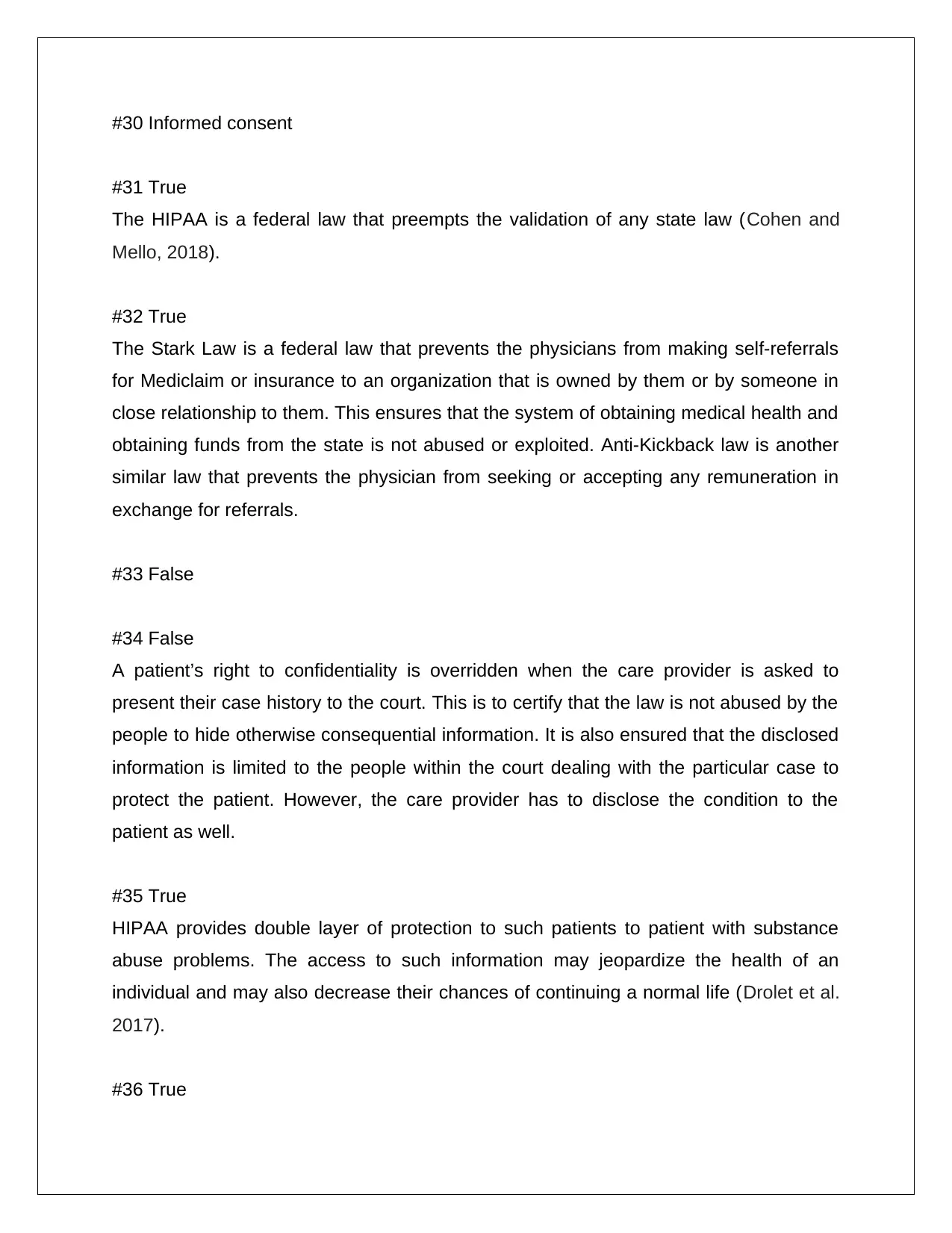
#30 Informed consent
#31 True
The HIPAA is a federal law that preempts the validation of any state law (Cohen and
Mello, 2018).
#32 True
The Stark Law is a federal law that prevents the physicians from making self-referrals
for Mediclaim or insurance to an organization that is owned by them or by someone in
close relationship to them. This ensures that the system of obtaining medical health and
obtaining funds from the state is not abused or exploited. Anti-Kickback law is another
similar law that prevents the physician from seeking or accepting any remuneration in
exchange for referrals.
#33 False
#34 False
A patient’s right to confidentiality is overridden when the care provider is asked to
present their case history to the court. This is to certify that the law is not abused by the
people to hide otherwise consequential information. It is also ensured that the disclosed
information is limited to the people within the court dealing with the particular case to
protect the patient. However, the care provider has to disclose the condition to the
patient as well.
#35 True
HIPAA provides double layer of protection to such patients to patient with substance
abuse problems. The access to such information may jeopardize the health of an
individual and may also decrease their chances of continuing a normal life (Drolet et al.
2017).
#36 True
#31 True
The HIPAA is a federal law that preempts the validation of any state law (Cohen and
Mello, 2018).
#32 True
The Stark Law is a federal law that prevents the physicians from making self-referrals
for Mediclaim or insurance to an organization that is owned by them or by someone in
close relationship to them. This ensures that the system of obtaining medical health and
obtaining funds from the state is not abused or exploited. Anti-Kickback law is another
similar law that prevents the physician from seeking or accepting any remuneration in
exchange for referrals.
#33 False
#34 False
A patient’s right to confidentiality is overridden when the care provider is asked to
present their case history to the court. This is to certify that the law is not abused by the
people to hide otherwise consequential information. It is also ensured that the disclosed
information is limited to the people within the court dealing with the particular case to
protect the patient. However, the care provider has to disclose the condition to the
patient as well.
#35 True
HIPAA provides double layer of protection to such patients to patient with substance
abuse problems. The access to such information may jeopardize the health of an
individual and may also decrease their chances of continuing a normal life (Drolet et al.
2017).
#36 True
⊘ This is a preview!⊘
Do you want full access?
Subscribe today to unlock all pages.

Trusted by 1+ million students worldwide
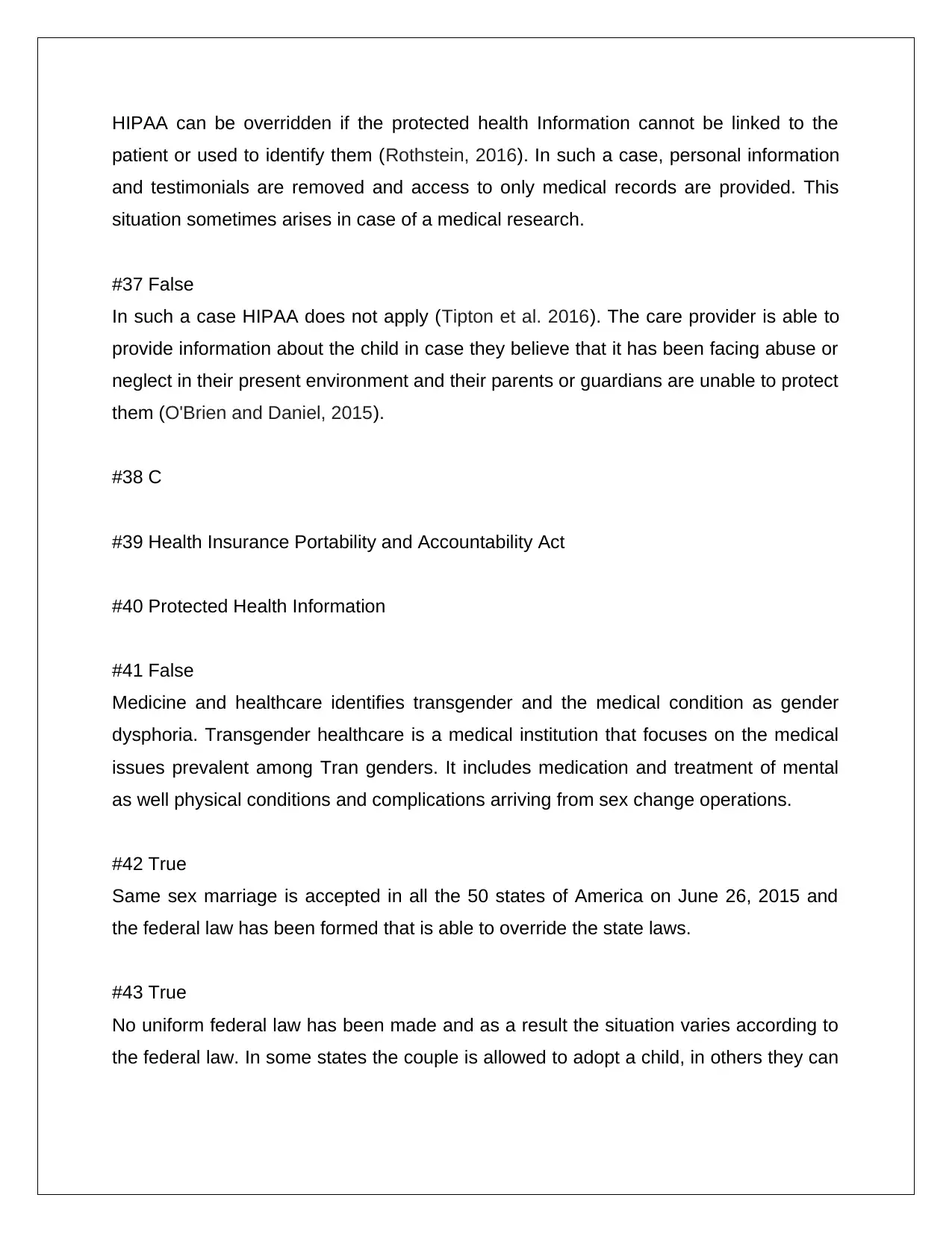
HIPAA can be overridden if the protected health Information cannot be linked to the
patient or used to identify them (Rothstein, 2016). In such a case, personal information
and testimonials are removed and access to only medical records are provided. This
situation sometimes arises in case of a medical research.
#37 False
In such a case HIPAA does not apply (Tipton et al. 2016). The care provider is able to
provide information about the child in case they believe that it has been facing abuse or
neglect in their present environment and their parents or guardians are unable to protect
them (O'Brien and Daniel, 2015).
#38 C
#39 Health Insurance Portability and Accountability Act
#40 Protected Health Information
#41 False
Medicine and healthcare identifies transgender and the medical condition as gender
dysphoria. Transgender healthcare is a medical institution that focuses on the medical
issues prevalent among Tran genders. It includes medication and treatment of mental
as well physical conditions and complications arriving from sex change operations.
#42 True
Same sex marriage is accepted in all the 50 states of America on June 26, 2015 and
the federal law has been formed that is able to override the state laws.
#43 True
No uniform federal law has been made and as a result the situation varies according to
the federal law. In some states the couple is allowed to adopt a child, in others they can
patient or used to identify them (Rothstein, 2016). In such a case, personal information
and testimonials are removed and access to only medical records are provided. This
situation sometimes arises in case of a medical research.
#37 False
In such a case HIPAA does not apply (Tipton et al. 2016). The care provider is able to
provide information about the child in case they believe that it has been facing abuse or
neglect in their present environment and their parents or guardians are unable to protect
them (O'Brien and Daniel, 2015).
#38 C
#39 Health Insurance Portability and Accountability Act
#40 Protected Health Information
#41 False
Medicine and healthcare identifies transgender and the medical condition as gender
dysphoria. Transgender healthcare is a medical institution that focuses on the medical
issues prevalent among Tran genders. It includes medication and treatment of mental
as well physical conditions and complications arriving from sex change operations.
#42 True
Same sex marriage is accepted in all the 50 states of America on June 26, 2015 and
the federal law has been formed that is able to override the state laws.
#43 True
No uniform federal law has been made and as a result the situation varies according to
the federal law. In some states the couple is allowed to adopt a child, in others they can
Paraphrase This Document
Need a fresh take? Get an instant paraphrase of this document with our AI Paraphraser
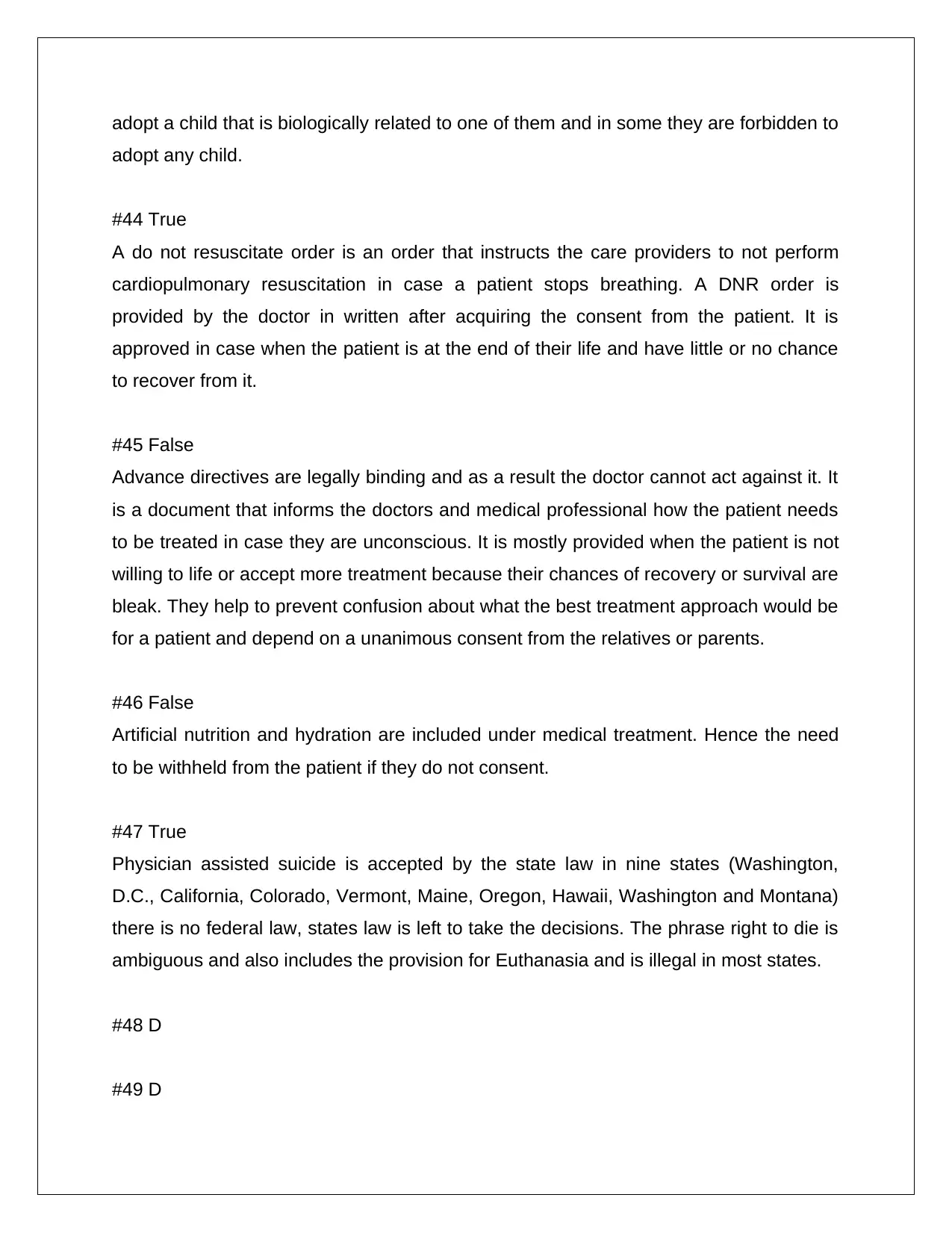
adopt a child that is biologically related to one of them and in some they are forbidden to
adopt any child.
#44 True
A do not resuscitate order is an order that instructs the care providers to not perform
cardiopulmonary resuscitation in case a patient stops breathing. A DNR order is
provided by the doctor in written after acquiring the consent from the patient. It is
approved in case when the patient is at the end of their life and have little or no chance
to recover from it.
#45 False
Advance directives are legally binding and as a result the doctor cannot act against it. It
is a document that informs the doctors and medical professional how the patient needs
to be treated in case they are unconscious. It is mostly provided when the patient is not
willing to life or accept more treatment because their chances of recovery or survival are
bleak. They help to prevent confusion about what the best treatment approach would be
for a patient and depend on a unanimous consent from the relatives or parents.
#46 False
Artificial nutrition and hydration are included under medical treatment. Hence the need
to be withheld from the patient if they do not consent.
#47 True
Physician assisted suicide is accepted by the state law in nine states (Washington,
D.C., California, Colorado, Vermont, Maine, Oregon, Hawaii, Washington and Montana)
there is no federal law, states law is left to take the decisions. The phrase right to die is
ambiguous and also includes the provision for Euthanasia and is illegal in most states.
#48 D
#49 D
adopt any child.
#44 True
A do not resuscitate order is an order that instructs the care providers to not perform
cardiopulmonary resuscitation in case a patient stops breathing. A DNR order is
provided by the doctor in written after acquiring the consent from the patient. It is
approved in case when the patient is at the end of their life and have little or no chance
to recover from it.
#45 False
Advance directives are legally binding and as a result the doctor cannot act against it. It
is a document that informs the doctors and medical professional how the patient needs
to be treated in case they are unconscious. It is mostly provided when the patient is not
willing to life or accept more treatment because their chances of recovery or survival are
bleak. They help to prevent confusion about what the best treatment approach would be
for a patient and depend on a unanimous consent from the relatives or parents.
#46 False
Artificial nutrition and hydration are included under medical treatment. Hence the need
to be withheld from the patient if they do not consent.
#47 True
Physician assisted suicide is accepted by the state law in nine states (Washington,
D.C., California, Colorado, Vermont, Maine, Oregon, Hawaii, Washington and Montana)
there is no federal law, states law is left to take the decisions. The phrase right to die is
ambiguous and also includes the provision for Euthanasia and is illegal in most states.
#48 D
#49 D

#50 A and D
⊘ This is a preview!⊘
Do you want full access?
Subscribe today to unlock all pages.

Trusted by 1+ million students worldwide
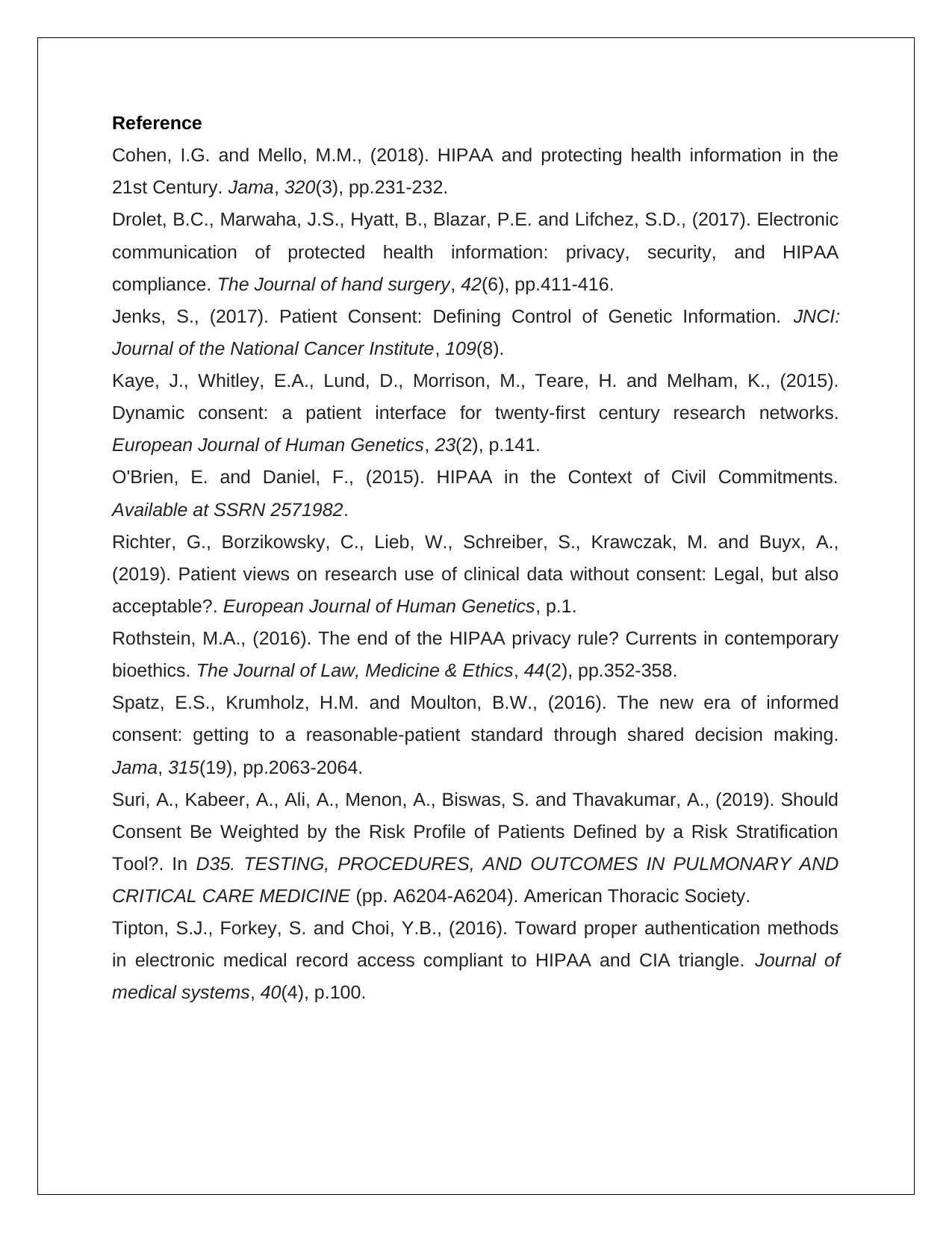
Reference
Cohen, I.G. and Mello, M.M., (2018). HIPAA and protecting health information in the
21st Century. Jama, 320(3), pp.231-232.
Drolet, B.C., Marwaha, J.S., Hyatt, B., Blazar, P.E. and Lifchez, S.D., (2017). Electronic
communication of protected health information: privacy, security, and HIPAA
compliance. The Journal of hand surgery, 42(6), pp.411-416.
Jenks, S., (2017). Patient Consent: Defining Control of Genetic Information. JNCI:
Journal of the National Cancer Institute, 109(8).
Kaye, J., Whitley, E.A., Lund, D., Morrison, M., Teare, H. and Melham, K., (2015).
Dynamic consent: a patient interface for twenty-first century research networks.
European Journal of Human Genetics, 23(2), p.141.
O'Brien, E. and Daniel, F., (2015). HIPAA in the Context of Civil Commitments.
Available at SSRN 2571982.
Richter, G., Borzikowsky, C., Lieb, W., Schreiber, S., Krawczak, M. and Buyx, A.,
(2019). Patient views on research use of clinical data without consent: Legal, but also
acceptable?. European Journal of Human Genetics, p.1.
Rothstein, M.A., (2016). The end of the HIPAA privacy rule? Currents in contemporary
bioethics. The Journal of Law, Medicine & Ethics, 44(2), pp.352-358.
Spatz, E.S., Krumholz, H.M. and Moulton, B.W., (2016). The new era of informed
consent: getting to a reasonable-patient standard through shared decision making.
Jama, 315(19), pp.2063-2064.
Suri, A., Kabeer, A., Ali, A., Menon, A., Biswas, S. and Thavakumar, A., (2019). Should
Consent Be Weighted by the Risk Profile of Patients Defined by a Risk Stratification
Tool?. In D35. TESTING, PROCEDURES, AND OUTCOMES IN PULMONARY AND
CRITICAL CARE MEDICINE (pp. A6204-A6204). American Thoracic Society.
Tipton, S.J., Forkey, S. and Choi, Y.B., (2016). Toward proper authentication methods
in electronic medical record access compliant to HIPAA and CIA triangle. Journal of
medical systems, 40(4), p.100.
Cohen, I.G. and Mello, M.M., (2018). HIPAA and protecting health information in the
21st Century. Jama, 320(3), pp.231-232.
Drolet, B.C., Marwaha, J.S., Hyatt, B., Blazar, P.E. and Lifchez, S.D., (2017). Electronic
communication of protected health information: privacy, security, and HIPAA
compliance. The Journal of hand surgery, 42(6), pp.411-416.
Jenks, S., (2017). Patient Consent: Defining Control of Genetic Information. JNCI:
Journal of the National Cancer Institute, 109(8).
Kaye, J., Whitley, E.A., Lund, D., Morrison, M., Teare, H. and Melham, K., (2015).
Dynamic consent: a patient interface for twenty-first century research networks.
European Journal of Human Genetics, 23(2), p.141.
O'Brien, E. and Daniel, F., (2015). HIPAA in the Context of Civil Commitments.
Available at SSRN 2571982.
Richter, G., Borzikowsky, C., Lieb, W., Schreiber, S., Krawczak, M. and Buyx, A.,
(2019). Patient views on research use of clinical data without consent: Legal, but also
acceptable?. European Journal of Human Genetics, p.1.
Rothstein, M.A., (2016). The end of the HIPAA privacy rule? Currents in contemporary
bioethics. The Journal of Law, Medicine & Ethics, 44(2), pp.352-358.
Spatz, E.S., Krumholz, H.M. and Moulton, B.W., (2016). The new era of informed
consent: getting to a reasonable-patient standard through shared decision making.
Jama, 315(19), pp.2063-2064.
Suri, A., Kabeer, A., Ali, A., Menon, A., Biswas, S. and Thavakumar, A., (2019). Should
Consent Be Weighted by the Risk Profile of Patients Defined by a Risk Stratification
Tool?. In D35. TESTING, PROCEDURES, AND OUTCOMES IN PULMONARY AND
CRITICAL CARE MEDICINE (pp. A6204-A6204). American Thoracic Society.
Tipton, S.J., Forkey, S. and Choi, Y.B., (2016). Toward proper authentication methods
in electronic medical record access compliant to HIPAA and CIA triangle. Journal of
medical systems, 40(4), p.100.
1 out of 10
Related Documents
Your All-in-One AI-Powered Toolkit for Academic Success.
+13062052269
info@desklib.com
Available 24*7 on WhatsApp / Email
![[object Object]](/_next/static/media/star-bottom.7253800d.svg)
Unlock your academic potential
Copyright © 2020–2025 A2Z Services. All Rights Reserved. Developed and managed by ZUCOL.





